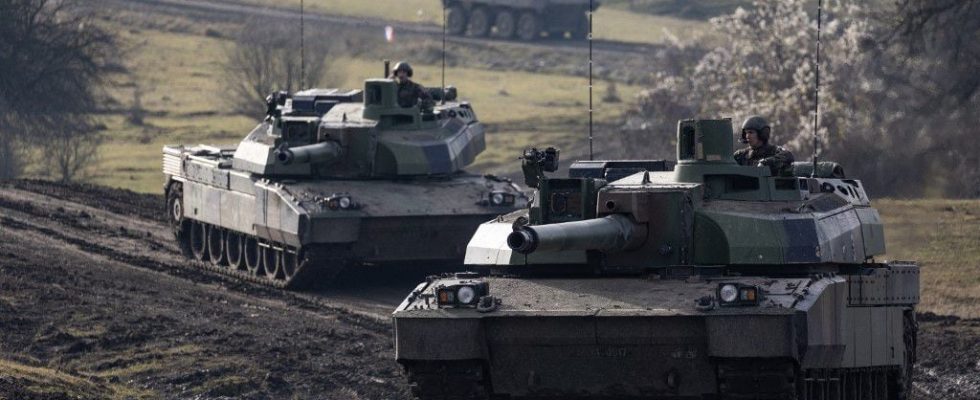Could World War III take place next year between Russia and the NATO countries? Across the Rhine, this scenario seems far from unrealistic. The German daily Bild went around the world by publishing its front page this Monday, January 15 entitled: “The Bundeswehr is preparing for an attack against Putin”. The newspaper says it has obtained a confidential document from the German army, called “Alliance Defense 2025”, in which a direct conflict between Russia and Western countries could well become a reality by 2025.
Everything would start in February 2024 with a new Russian military mobilization of nearly 200,000 men – although we know that Russia is starting to face difficulties in renewing its troops, and could even naturalize foreign fighters to join its army. But according to the German scenario, recruitment difficulties on the Ukrainian side, coupled with reduced Western support, could lead Moscow’s army to a victorious offensive at the end of spring.
Putin would not stop there. The Baltic countries would be the next target, through violent cyberattacks and the agitation of Russian ethnic minorities present in these countries, going so far as to cause clashes. It was then that Moscow, associated with its Belarusian ally, would trigger military maneuvers called “Zapad 2024” – named after an existing joint exercise between Moscow and Minsk and the last edition of which took place in 2021, mobilizing nearly 50,000 troops in western Russia and Belarus. A scenario which is reminiscent of the massing of Russian soldiers on the border with Ukraine before the attack of February 2022.
The Kaliningrad enclave at the heart of a future conflict?
The similarities with the invasion of Ukraine do not end there. Still according to the Bundeswehr, a new threat would then be pretexted to allow Russia to continue its offensive. This would indeed be the small Russian enclave of Kaliningrad, located between Poland and Lithuania. In October 2024, Putin would ensure that NATO intimidates this territory of just over 200 km² in order to mass troops and medium-range missiles there. Before finally beginning an offensive on the Suwalki corridor, a little over 65 kilometers which connects Kaliningrad to Belarus, thus cutting off the Baltic countries from the rest of Europe. All in December 2024, following the American elections leading to instability in the region, allowing Russia to trigger a “border” conflict and “riots with many deaths”.
The German army scenario then continues. He imagines that from January 2025, this attack would lead to the seizure of the NATO Security Committee by the Baltic countries and Poland – article 5 of the military organization stipulating a mutual assistance pact in the event of an attack against one of its members. NATO would thus put in place “credible deterrent measures” from May 2025 in Europe, by mobilizing more than 300,000 soldiers, including 30,000 Germans. More than 500,000 Russian and Western troops would face each other in eastern Europe, very close to a military escalation. And if the Bundeswehr does not predict the future, the region would be on the verge of explosion.
“Last year’s horoscope”
If all this remains a military exercise, it still led to a reaction from the various protagonists. In Bild, a spokesperson for the German Defense Ministry neither confirmed nor denied the existence of such a document. “Examining different scenarios, even if they are extremely improbable, is part of everyday military activities, especially in the field of training,” he explained.
Russia, for its part, mocked the publication of this scenario. Kremlin spokesman Dmitry Peskov said he would not “comment on this report Bild“, emphasizing that “this newspaper regularly stooped to publishing false information and hoaxes” to the official Russian press agency Tass. The spokesperson for the Russian Ministry of Foreign Affairs, Maria Zakharova, for her part qualified the publication of Bild of “last year’s horoscope”.
Realistic factors
Of course, all this is fictitious, and is mainly a means for the German army to explore all the possibilities and turns that the conflict in Ukraine could take. We must not forget that for many more or less reliable analysts, the invasion of Ukraine in February 2022 was also described as unrealistic or impossible. And this despite numerous warning signs, such as the massing of Russian troops at the border justified by so-called “military exercises”.
Several factors in this scenario of Bundeswehr are nevertheless far from being fanciful, whether it is the uncertainty over the sustainability of Western support for Ukraine or even a victory for Donald Trump in the American presidential election which would cast great doubt on the involvement of the United States in Europe. The future of the Baltic countries, threatened by the expansionist desires of Vladimir Putin, also led L’Express to devote an episode of its dark scenarios of the French army from February 2023, materialized by a Russian military invasion of Lithuania and Estonia. This type of exercise or fiction in any case allows us to recall one certainty: Vladimir Putin is not one of those who will back down.
